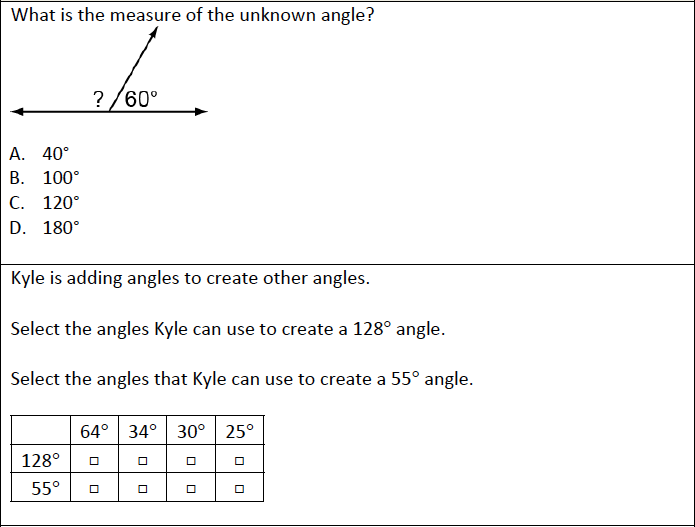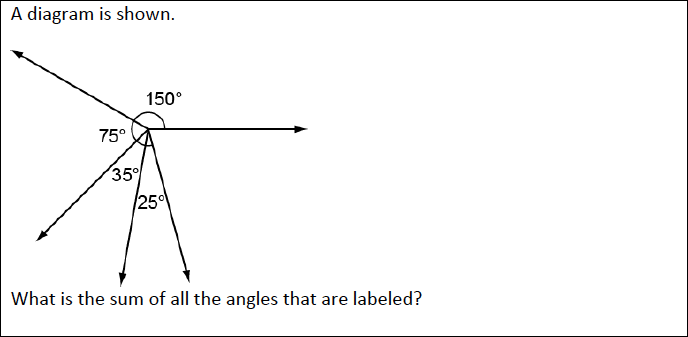Recognize angle measure as additive. When an angle is decomposed into non-overlapping parts, the angle measure of the whole is the sum of the angle measures of the parts. Solve addition and subtraction problems to find unknown angles on a diagram in real world and mathematical problems, e.g., by using an equation with a symbol for the unknown angle measure.
[divider] [/divider]Students are able to…
- Relate addition and subtraction to finding unknown angles.
- Write equations to represent an unknown angle.
- Solve real world problems that involve composing and decomposing angles.
[divider] [/divider]Students are able to…because teachers:
- Provide hands on tasks where students are decomposing an angle into parts and proving that the sum of the parts equals the original angle.
- Ensure students justify their findings verbally and through use of equations and models.
- Pose real world situations for students to problem solve.
[divider] [/divider]Questions to ask students:
- Point to a missing angle and ask… What information do you need to know to find the missing angle measure?
- Sample answer that indicates understanding: I need to know how big the whole angle and the other parts are. I can use that information to subtract and find the missing angle.
- Sample answer that indicates an incomplete understanding or a misconception: I can only find the measure of the angle with a protractor.
- Write an addition or subtraction equation to represent the missing angle measure.
- Sample answer that indicates understanding: The total angle measure was 90˚ and one of the decomposed angle measures is 50˚, so 50˚+ a = 90˚. Or 90˚- 50˚ = a. So the missing angle measure is 40˚.
- Write an addition or subtraction equation to represent the combined angle measures.
- Sample answer that indicates understanding: The two angle measures are 110˚ and 70˚. When we combine the two angle measures the total combined measure is 180˚.
- Pose the question, “If I have a right angle and I draw another ray inside that measures 60˚, what would the measure of the remaining angle be?”
- Sample answer that indicates understanding: A right angle is 90˚. 30 + 60 = 90. The missing angle would be 30˚.
[divider] [/divider]FSA Notes
Cognitive Complexity Level: 2 – Basic Application of Skills and Concepts
Achievement Level Descriptors:
2- recognizes that angle measure is additive; solves addition real-world and mathematical problems to find unknown angles on a diagram with no more than two angles, within a 90-degree angle
3- solves addition and subtraction real-world and mathematical problems to find unknown angles on a diagram with no more than two angles, within a 180-degree angle
4- finds unknown angles on a diagram with more than two angles and between 180- and 360-degrees total
5- given angle parameters, decomposes into multiple angles and gives the measure of each angle in relationship to the whole
Assessment Limits:
Whole number degree measures, sums, and differences may only be within 0° and 360°.
[divider] [/divider]Additional Resources:
Additional in depth content knowledge
[divider] [/divider]Sample Formative Assessment Tasks:
Resources/Tasks to Help Your Child at Home
Draw angles to have your child measure. Have them decompose the angle into two smaller angles and measure with a protractor the angle in degrees and then record the smaller angle measures. Extend to have them decompose in different ways. Consider extending to give the larger angle measure and one of the smaller angle measures, then they have your child determine the missing angle measure.
Adjacent Angles Online Math Game https://goo.gl/phijMY
Khan Academy: Decomposing an Angle https://goo.gl/fCjZ5Q


